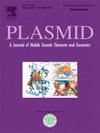Single-strain mobilome sequencing quantifies bacterial genetic response to stress, including activity of IS elements, prophages, RNAs, and REPINs.
IF 2.2
4区 生物学
Q3 GENETICS & HEREDITY
引用次数: 0
Abstract
Microbial genomes are continuously being rearranged by mobile genetic elements (MGEs), leading to configurations that may confer novel phenotypic traits such as antibiotic resistance, degradation of compounds, or metabolic features. Standard genomic sequencing provides a snapshot of a genome in one configuration, but this static image does not give insight into the dynamics of genomic evolution and whether MGEs are actively changing a genome. We applied single-strain mobilome sequencing to Escherichia coli K-12 MG1655 under various stress conditions: UV, SDS, nalidixic acid, tetracycline, cetrimide, and copper. Under these conditions, we quantified the activity of a range of genetic elements, including extrachromosomal circular DNA (eccDNA) from IS elements, RNA genes, the UV-inducible e14 prophage, and intergenic repetitive sites (REP). Of the stressors, copper and SDS are among the largest inducers of eccDNA formation from some IS elements, while elevated levels of hypothetical RNA/DNA heteroduplexes of ribosomal and transfer RNAs, and Rhs-nuclease proteins are induced under various stressors, especially copper and SDS. This approach holds promise for quantifying the genetic response to environmental stress and implications for genome plasticity. The mobilization of IS elements upon copper and other stressors helps to explain co-selection of heavy metals with antibiotic resistance genes and MGEs.
单菌株移动组测序量化细菌对应激的遗传反应,包括IS元件、前噬菌体、rna和REPINs的活性。
微生物基因组不断被移动遗传元件(MGEs)重新排列,导致可能赋予新的表型特征的结构,如抗生素耐药性、化合物降解或代谢特征。标准的基因组测序提供了基因组在一种结构中的快照,但这种静态图像并不能深入了解基因组进化的动态以及MGEs是否正在积极地改变基因组。我们对大肠杆菌K-12 MG1655在不同的胁迫条件下进行了单株移动组测序:紫外、SDS、萘啶酸、四环素、氰胺和铜。在这些条件下,我们量化了一系列遗传元件的活性,包括来自IS元件的染色体外环状DNA (eccDNA)、RNA基因、uv诱导的e14噬菌体和基因间重复位点(REP)。在应激源中,铜和SDS是一些IS元件形成eccDNA的最大诱导剂,而在各种应激源下,尤其是铜和SDS,可诱导核糖体和转移RNA的假想RNA/DNA异双链和rhs -核酸酶蛋白水平升高。这种方法有望量化遗传对环境压力的反应和对基因组可塑性的影响。IS元素在铜和其他应激源上的动员有助于解释重金属与抗生素抗性基因和MGEs的共选择。
本文章由计算机程序翻译,如有差异,请以英文原文为准。
求助全文
约1分钟内获得全文
求助全文
来源期刊

Plasmid
生物-遗传学
CiteScore
4.70
自引率
3.80%
发文量
21
审稿时长
53 days
期刊介绍:
Plasmid publishes original research on genetic elements in all kingdoms of life with emphasis on maintenance, transmission and evolution of extrachromosomal elements. Objects of interest include plasmids, bacteriophages, mobile genetic elements, organelle DNA, and genomic and pathogenicity islands.
 求助内容:
求助内容: 应助结果提醒方式:
应助结果提醒方式:


